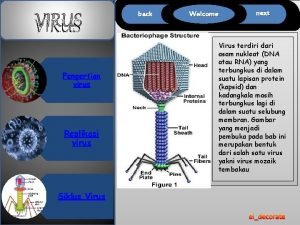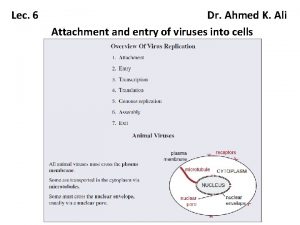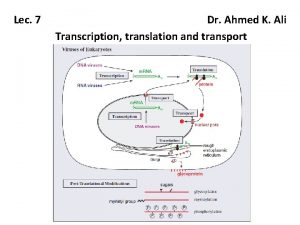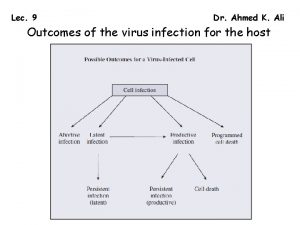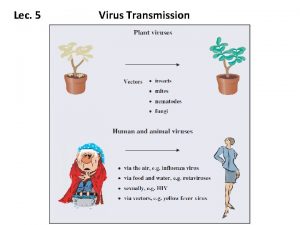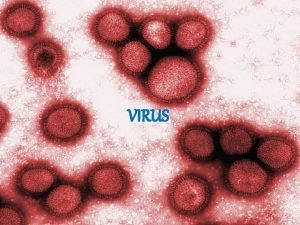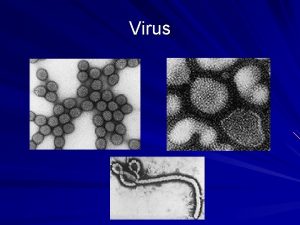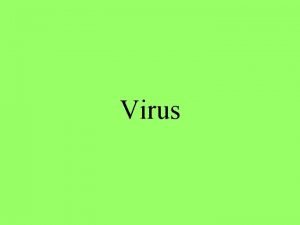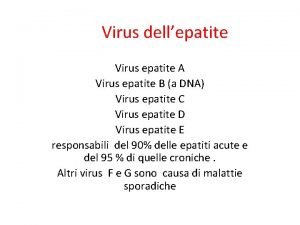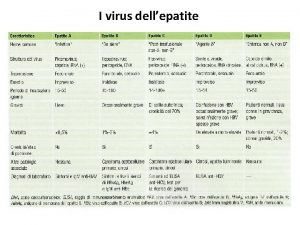Lec 5 Virus Transmission Dr Ahmed K Ali














- Slides: 14

Lec. 5 Virus Transmission Dr. Ahmed K. Ali

§ In order not to die out, viruses must be propagated and transmitted to new hosts in which more virions can be produced. The only other way for the survival of virus genes is to be maintained as in cells as nucleic acids, which are replicated and passed on to daughter cells when the cells divide. § Viruses of bacteria and other microbial hosts are released from infected cell into the environment of the host to find more susceptible cells that are likely to be present. § Viruses of multicellular animals and plants must also find new cells to infect. An infection may spread from cell to cell, or to cell in adjacent part of the host after transport in the blood of an animal or in the phloem of a plant. Ultimately a virus must find new host to infect in order to survive. • Transmission via vectors: general concept Many viruses are transmitted between hosts by organisms that feed on them. These organisms act as vectors. Most vectors of viruses are arthropods (insects, mites, ticks). The arthropod-transmitted viruses of vertebrates are sometimes referred to as arboviruses (arthropod-born viruses).

• The mechanism of virus transmission via vectors During its feeding on the infected host, the vector acquires a virus and transmits the virus to one or more new hosts. Some viruses are transmitted after virions have become attached to the mouthparts of their vectors during feeding. Transmission in this way may occur within seconds or minutes of the vector acquiring virus. Many vector-transmitted viruses, however, cross the gut wall of the vector and enter its circulatory system. The virus ultimately reaches the salivary glands and is secreted into the saliva, which may transport virus into new hosts when the vector feeds. This mode of transmission is said to be circulative, and transmission does not occur until hours or days after the vector has acquired the virus. Some circulative viruses replicate in one or more tissues and organs of their vectors; thus there are viruses that can replicate in both invertebrates and plants, and viruses that can replicate in both invertebrates and vertebrates. If the reproductive organs of the vector are infected there may be possibilities for vector-to-vector transmission. Some viruses are sexually transmitted (male to female and vice versa) and some are transmitted to the next generation within the egg; the latter is known as transovarial transmission.

Mosquito’s organs and tissues may become infected by a virus acquired in a blood meal.

• Transmission of plant viruses Plant cells are surrounded by thick cell walls that present significant barriers to virus entry; most plant viruses are carried across these barriers by vectors. A wide variety of organisms use plants as sources of nutrition and some of these organisms, especially invertebrates, act as virus vectors. Many of the vectors (e. g. aphids, nematodes) feed by piercing cell walls and ingesting the contents, while beetles feed by biting. The most common vectors of plant viruses are aphids, which, as we have already pointed out, feed by ingesting the contents of cells. The nematodes that transmit viruses are soil-dwelling animals that pierce root cells and then ingest their contents. The basis of some cases of plant virus-vector specificity lies in specific amino acid sequences in capsid proteins. In other cases important roles are played by viruscoded non-structural proteins (helper factors) that are synthesized in the infected plant cell. Virions may bind specifically to structures in the mouthparts of their vectors via specific sequences on the surfaces of capsids and/or helper factors.

About 20 per cent of plant viruses can be transmitted vertically; in other words, seed can be infected, leading to infection of the next generation. Most seedtransmitted viruses are carried in the embryo, which may have acquired its infection from either an infected ovule or an infected pollen grain. Examples of viruses that can be transmitted via seed include the nepoviruses and the tobraviruses, two groups of nematode-transmitted viruses mentioned above. Many plant viruses can also be transmitted by artificial means; for example, grafting material from a virus-infected plant can introduce virus into a new host.

Insects Example of virus transmitted

Transmission of vertebrates viruses 1. Non-vector transmission of vertebrate viruses Many viruses of vertebrates (including humans) infect their hosts via the mucous membranes of the upper respiratory tract. An infected individual may shed viruscontaining droplets into the air during sneezing, speaking and coughing, and new hosts may become infected by inhaling this material.

Virus present in genital secretions can be transmitted during sexual contact, while viruses infecting the intestinal tract are shed in feces and may enter new hosts ingesting feces-contaminated food or water. Some viruses may be released from lesions, for example foot and mouth disease virus from lesions on the feet and in the mouth, papillomaviruses from warts, and herpes simplex virus from lesions on the lips. These viruses could be transmitted directly by contact between an infected host and a non-infected host, or they could be transmitted indirectly through contamination of the environment. Transmission of rabies virus, for example from dog to human, requires a bite from an infected mammal to introduce virus-containing saliva into the body. In most of the cases discussed so far the host becomes infected when epithelial cells and/or lymphoid cells at a body surface become infected. Some infections (e. g. common cold, rotavirus) remain limited to these tissues, while others (e. g. measles, polio, HIV) cross the epithelial surface and spread to other organs and tissues. Vertical transmission: transmission of viruses directly from a parent to members of next generation.


2. Vector transmission of vertebrate viruses Vector that acquire their viruses when they take blood meals from infected animals. Obviously for this to occur virus must be present in the blood of infected animalsectors that transmit vertebrate viruses are mainly blood-feeding arthropods, a situation known as viraemia. Some arthropod parasites that acquire virus infections from the vertebrates on which they feed remain infected for life. This is the case with ticks that become infected with tick-borne encephalitis virus. Transovarial transmission has been demonstrated for a number of viruses, including yellow fever virus in mosquitoes. Viruses in blood or blood products can be transmitted during medical procedures by inanimate ‘vectors’ such as blood transfusion equipment and syringes and needles. Viruses can also be transmitted when needles for drug injection are shared, when needlestick injuries occur and when hemophiliacs are injected with blood factors containing viruses.


• Transmission of invertebrate viruses In addition to animals and plants, invertebrates are hosts to many other viruses that replicate only in invertebrates; most of the known invertebrate viruses have insect hosts. Many of these viruses have evolved occlusion bodies, which are large protein structures in which virions become embedded in the infected cell. Viruses that produce occlusion bodies include cypoviruses and baculoviruses. Occlusion bodies may be expelled in the feces of a virus-infected insect or they may remain in the host until it is ingested by a predator or it dies as a result of the virus infection. They are robust structures, able to survive putrefaction of the host and providing protection for virions in the outside environment. New insects become infected when occlusion bodies become ingested along with food, which is often plant material. Enzymes and high p. H in the gut break down occlusion bodies, releasing the virions.

Vertical transmission and vector transmission of a number of invertebrate viruses have been reported. Vertical transmission may occur either within eggs (transovarially) or on the surface of eggs. Vectors involved in virus transmission between insect hosts include parasitic wasps.
